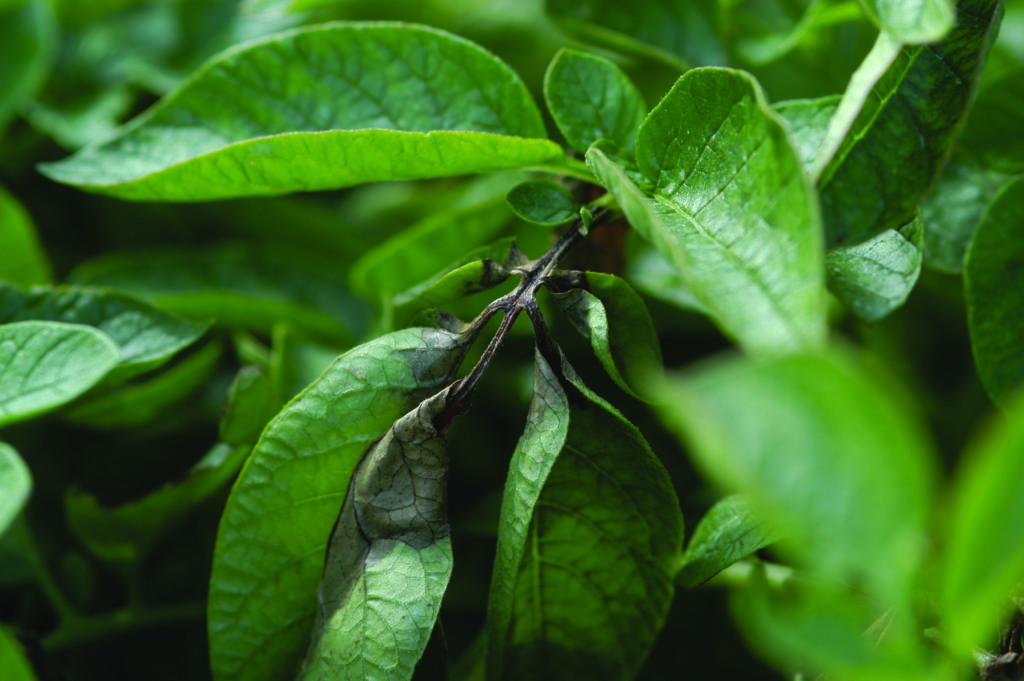
Canopy environment in irrigation a key factor for managing late blight in semiarid environments
Late blight, caused by Phytophthora infestans, is typically not expected to be a problem in the Columbia Basin of Washington and Oregon because the disease is disfavored by the semiarid environment. Cool, wet weather with rainfall, ambient relative humidity above 90 percent, and temperatures of 7 to 24°C (44.6- 75.2°F) favor late blight development. However, sprinkler irrigation modifies the environment within the potato crop canopy and increases the potential for late blight in semiarid regions. High humidity in the crop canopy favors sporulation of P. infestans and leaf wetness is crucial for infection.
The Columbia Basin is similar to other regions of the world where potato late blight is dependent on the physical environment for development. Foliage and tubers of potato cultivars grown in the region are susceptible to infection and aggressive genotypes of P. infestans are often present. When inoculum of P. infestans is present, only a favorable environment and sufficient time are needed for epidemic development.
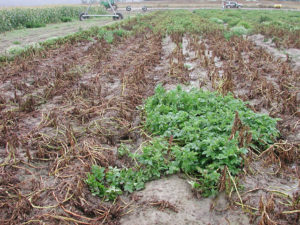
Ambient temperatures are generally favorable for late blight development after plant row closure in the Columbia Basin. Plant row closure is when foliage between rows comes in contact and, for the main cultivars grown including Russet Burbank, generally begins from the first to second week of June in the southern Columbia Basin to the end of June in the northern basin. The canopy environment after plant row closure often contributes to increased risk of epidemic development.
Late blight has not been observed before plant row closure in the region. However, once plant row closure has occurred, microclimate conditions generally are favorable for late blight development whenever a field is irrigated. Late blight is extremely difficult to manage once the disease is established in an irrigated field. For example, in a field with inoculum originating from infected seed tubers, incidence of late blight increased from 0.2 to 70 percent over a four-week period after canopy closure even with nine applications of efficacious fungicides.
A research study was recently completed that quantitatively characterized the canopy environment relative to risk of late blight in seven sprinkler irrigated potato fields in the Columbia Basin over five years. Relative humidity (RH), hours of RH > 90 percent, and temperature were found to be the best variables to estimate the potential effect of canopy environment on late blight development. Leaf wetness was not a reliable predictor for late blight development. Ambient environment data for temperature and rainfall for the study were taken from Washington State University AGWeatherNet stations nearest the trial field stations.
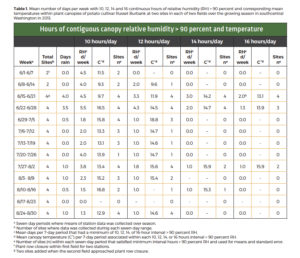 The microenvironment near potato plants did not favor potential late blight development before plant row closure (Table 1), and explains why late blight has not been observed in potato fields before plant row closure in the Columbia Basin. This result was expected since air movement and solar irradiance are not restricted by a dense plant canopy and ambient relative humidity is relatively low in the semiarid atmosphere.
The microenvironment near potato plants did not favor potential late blight development before plant row closure (Table 1), and explains why late blight has not been observed in potato fields before plant row closure in the Columbia Basin. This result was expected since air movement and solar irradiance are not restricted by a dense plant canopy and ambient relative humidity is relatively low in the semiarid atmosphere.
However, the microenvironment within the canopy at and after plant row closure was frequently favorable for late blight development (Fig. 1). Favorable late blight periods after plant row closure occurred up to seven days per week and 87 percent of the weeks had late blight favorable days. Temperatures during humid periods were mostly favorable for late blight after plant row closure (Table 1).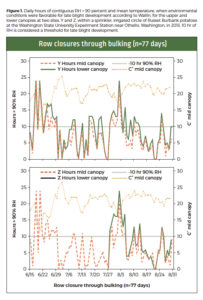
The mean hourly potato canopy and ambient RH attained minima between 1,500 to 1,700 hours. From the minima, the RH increased rapidly to approximately 2,200 hours then increased moderately until attaining maxima at 0600 hours (Fig. 2). Ambient RH was consistently less and ambient temperature was greater than values recorded in the potato canopy after plant row closure.
Humid periods were longer in June than in July and August. Consequently, fungicides for late blight management can often be justified in June, especially after relatively wet weather in April and May, which is associated with late blight epidemics in the Columbia Basin.
Favorable periods for late blight were often accompanied by rain in a study in Minnesota where potatoes were not sprinkler irrigated. Rainfall, when it did occur in the semiarid environment of the Columbia Basin, was highly associated with long durations of humid periods throughout the trial period. The longest periods of RH > 90 percent were highly correlated with rainy days. Rainy days are often accompanied by cloud cover and reduced solar irradiance which is associated with a high incidence of late blight in the Columbia Basin. However, favorable late blight periods occurred in this study without rain and were a factor of sprinkler irrigation. Favorable periods for late blight in the Columbia Basin would be extended with rainfall and increase the potential for late blight development and promote spread within and between fields.
Fungicide application just before major rainfall is essential in the Columbia Basin if inoculum is present between plant row closure and harvest. Forecasts for rain are beneficial in scheduling fungicide application for late blight in the Columbia Basin.
Significant differences for mean RH and number of days with hours of RH > 90 percent were observed between monitoring sites within a test field (Fig. 1) where the topography of the field varied. Readings in a gradual swale were more humid than on a crown. Humidity readings were more consistent across fields where fields were relatively flat. Consequently, variation within fields needs to be considered when scouting for and managing late blight.
More hours of RH > 90 percent occurred and mean RH was higher at the low- than the mid-canopy level. As expected, canopy height is also a factor in placing environmental monitoring sensors and on late blight development.
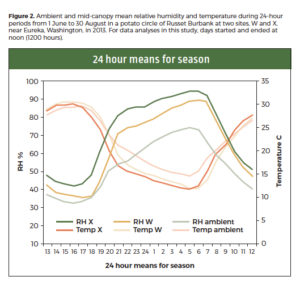 Canopy temperatures were generally favorable for late blight development after plant row closure in the Columbia Basin. Low temperatures near 7°C (45°F) were sometimes encountered in June and would likely retard but may not totally prevent late blight development. Late blight may slowly develop when temperatures are less than those considered as favorable in some disease forecasting models. Late blight development progressed slowly in the tropical highland regions of the Toluca Valley of Mexico at temperatures below thresholds of 7 to 10°C (45 to 50°F). Relatively high levels of inoculum and long humid and wet periods may compensate for relatively low temperatures for infection. Because temperatures are generally favorable for late blight development, they may not need to be a major component for late blight management models after plant row closure in the Columbia Basin.
Canopy temperatures were generally favorable for late blight development after plant row closure in the Columbia Basin. Low temperatures near 7°C (45°F) were sometimes encountered in June and would likely retard but may not totally prevent late blight development. Late blight may slowly develop when temperatures are less than those considered as favorable in some disease forecasting models. Late blight development progressed slowly in the tropical highland regions of the Toluca Valley of Mexico at temperatures below thresholds of 7 to 10°C (45 to 50°F). Relatively high levels of inoculum and long humid and wet periods may compensate for relatively low temperatures for infection. Because temperatures are generally favorable for late blight development, they may not need to be a major component for late blight management models after plant row closure in the Columbia Basin.
Mid-canopy relative humidity and temperature were comparable to the corresponding ambient values but differed in magnitude. However, the canopy and proximal ambient values were significantly and highly associated at all monitoring sites. This association may be used in modeling favorable conditions for late blight in a semiarid region with existing proximal weather stations. RH varied due to canopy height and field location in this study. Such variation should be accounted for when predicting the development of late blight and in making disease management decisions.
Wet periods from sprinkler irrigation after plant row closure are often sufficient in duration to promote late blight and should be accounted for in managing late blight. The management strategy in the Columbia Basin is to initially keep late blight out of fields because once a few plants are infected, late blight is extremely difficult to manage. However, before plant row closure in the Columbia Basin, fungicide applications are usually not warranted unless a prolonged rainy period is expected. Fungicides would then be needed to protect foliage from infection by sporangia that could be possibly produced on latently infected potato shoots arising from infected seed pieces and from other inoculum sources such as infected refuse tubers and infected volunteer potatoes.







